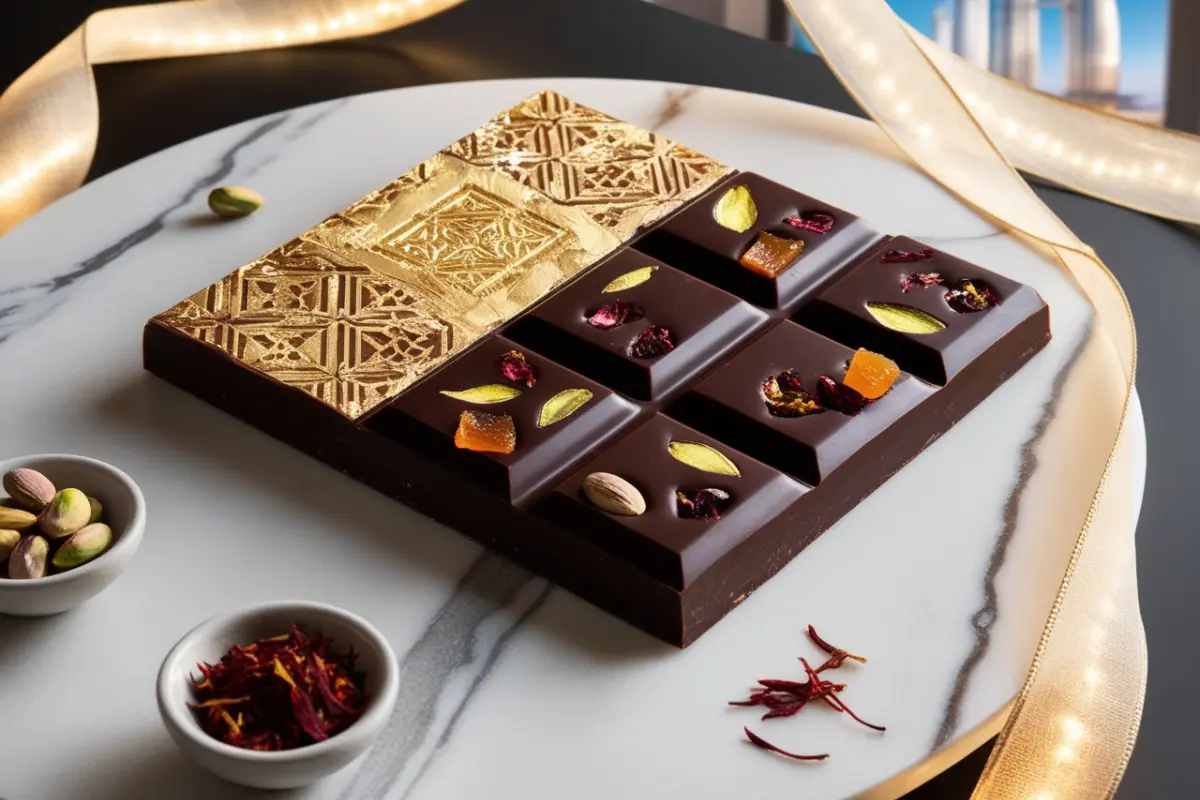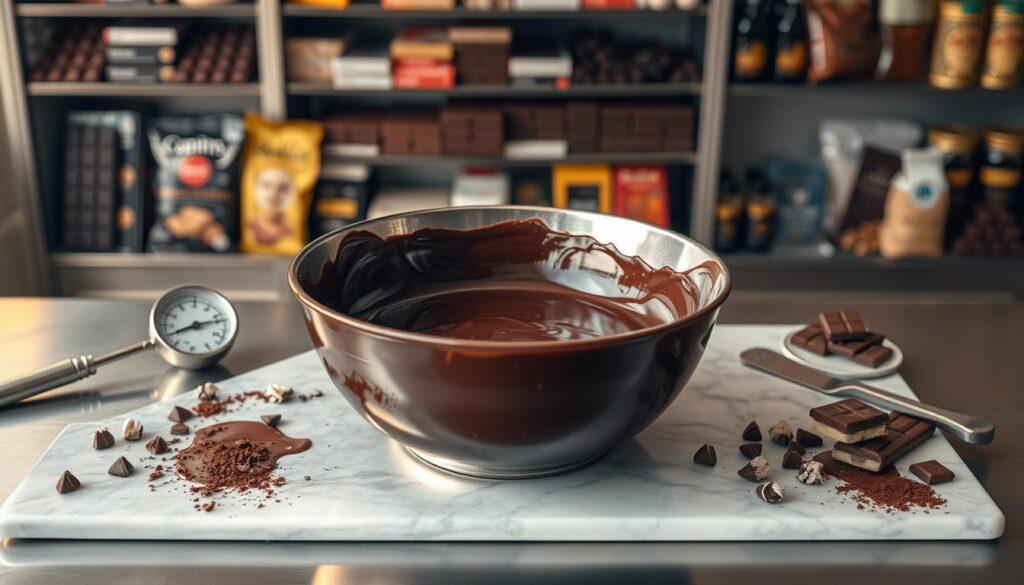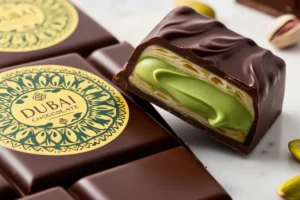The Dubai Chocolate Bar recipe is loved worldwide for its unique taste. It’s made with crunchy kataifi pastry, creamy pistachio filling, and a rich chocolate coating. You can choose between dark or milk chocolate. This Recipe makes two big chocolate bars, each weighing 500g/1.1lb, perfect for impressing anyone.
Key Takeaways
- The Dubai Chocolate Bar recipe makes two large 500g/1.1lb chocolate bars.
- The recipe includes crunchy kataifi pastry, pistachio cream, and tahini as the filling.
- The chocolate coating can be made with either dark or milk chocolate, depending on personal preference.
- The recipe is straightforward to make at home and delivers a distinctive Middle Eastern-inspired taste experience.
- Kataifi pastry can be found at Mediterranean or Middle Eastern grocery stores in the refrigerated section.
The Story Behind Dubai’s Viral Chocolate Creation
In Dubai, a small shop called Fix Dessert Chocolatier has made waves with its “Can’t Get Knafeh of It” chocolate bar. This bar mixes middle eastern confections with chocolate, becoming a hit worldwide.
Origin of Fix Dessert Chocolatier’s Innovation
The name “Fix” means “Freakin’ Incredible eXperience.” The founders aimed to mix Middle Eastern flavors with chocolate. They put crispy kataifi, pistachio, and tahini in milk chocolate, creating a new treat.
From Local Treat to Global Sensation
A viral ASMR video helped the “Can’t Get Knafeh of It” bar become famous. It got over 56 million views. Now, Fix Dessert Chocolatier gets 500 orders a day, with each bar costing $20.
Copycat versions of the bar are popping up online, selling for over $50. In South Africa, they’re even selling for 1,000 ZAR (about $56). Despite the rush, Fix Dessert Chocolatier keeps making their arabic sweet treats for fans worldwide.
“The ‘Can’t Get Knafeh of It’ chocolate bar has spurred a movement on social media, resulting in heightened interest and demand for this unique sweet treat.”
Essential Ingredients for Dubai Chocolate Bar Recipe
The Dubai chocolate bar recipe is a delicious Middle Eastern treat. It has become very popular. A few key ingredients make it so special.
The recipe starts with kataifi pastry, a shredded phyllo dough. It adds a unique texture to the bars. About 150g (1 and 1/2 cups) of this pastry is used, toasted in butter for extra flavor.
The filling is a mix of pistachio paste and tahini. Together, they make up 380g (13.4 oz). The pistachio paste gives a rich, nutty taste. The tahini adds a subtle sesame flavor.
A thick layer of dark or milk chocolate, about 500g (3 cups), wraps the filling. This chocolate layer not only tastes great but also keeps the bars together.
To make the bars look good, a bit of white chocolate (around 90g or 1/2 cup) is melted. It’s swirled into the chocolate, creating a marbled look.
Lastly, a sprinkle of pink and green chocolate is used for decoration. It adds color and a professional touch to these treats.
With these ingredients, anyone can make the famous Dubai chocolate bars at home. It’s a way to bring a taste of the Middle East into your kitchen.
Understanding Kataifi: The Secret Textural Element
Kataifi pastry is key in middle eastern confections and arabic sweet treats. It’s like shredded wheat or vermicelli noodles. It’s the main ingredient in desserts like Knafeh.
What is Kataifi Pastry?
Kataifi pastry is shredded filo dough. It’s very fine and delicate. This makes it crunchy and light, unlike regular filo.
This unique texture adds to the rich flavors of middle eastern confections.
Proper Storage and Handling
It’s important to handle kataifi carefully. Separate the strands gently before using. This prevents clumping and ensures even cooking.
Keep kataifi in the fridge. It stays fresh and delicate there.
Substitutes for Kataifi
- Vermicelli noodles can be a good substitute. Toasted, they get crunchy and work well with arabic sweet treats.
- Shredded phyllo dough is another option. It’s not the same, but it has a similar texture.
Using kataifi or its substitutes can make your middle eastern confections stand out. It adds a special textural experience.
Mastering the Chocolate Selection and Tempering
Making the perfect homemade Dubai chocolate bars starts with choosing the right chocolate. Dark chocolate is great for a less sweet taste, while milk chocolate adds sweetness. Tempering the chocolate is key for a smooth, shiny finish.
The Bain-marie method is a good way to temper chocolate. First, melt the chocolate in a bowl over hot water. Then, remove the bowl and add the rest of the chocolate. Stir until it’s all melted and at the right temperature:
- Dark chocolate: 88–90°F (31–32°C)
- Milk chocolate: 84–86°F (29-30°C)
- White chocolate: 82–84°F (28–29°C)
Tempering chocolate is a skill that takes practice. But, the results are amazing. Tempered chocolate looks glossy and snaps well. To check if it’s tempered right, dip a knife into the chocolate. It should harden quickly with a shiny finish.
Adding a bit of coconut oil to the chocolate makes it flow better. This helps create a smooth, professional-looking finish on your chocolate bars.
“Tempering chocolate is one of the most challenging skills to learn in the world of chocolate making, but the rewards are well worth the effort.”
With the right chocolate and tempering skills, you’re ready to make amazing homemade Dubai chocolate bars. They’ll impress anyone.
Pistachio Paste and Tahini Preparation
In Dubai’s lively food scene, a special chocolate has become a hit – the pistachio chocolate bars. Their amazing taste comes from making the pistachio paste and tahini filling with care.
Creating the Perfect Filling Consistency
Start by mixing top-quality pistachios with a bit of coconut oil. Blend until you get a smooth, spreadable paste. This pistachio paste is the base, adding a nutty taste.
Then, add traditional Greek tahini, or sesame paste, to the mix. Tahini balances the pistachio paste’s sweetness, adding a savory touch. You can adjust how much tahini you use to get the right mix of flavors and texture.
Balancing Sweet and Nutty Flavors
To mix the sweet and nutty tastes, add a bit of sea salt to the pistachio-tahini mix. This simple step boosts the flavors, creating a perfect balance that excites your taste buds.
The filling is a masterpiece of Dubai chocolate bars. It combines the creamy pistachio with the rich tahini for an unforgettable taste. This sweet and nutty mix is the perfect start for the rose water chocolate delights that will amaze you.
Step-by-Step Dubai Chocolate Bar Recipe
Try the delicious flavors of the Middle East with this dubai chocolate bar recipe. It combines crunchy kataifi pastry, creamy pistachio paste, and rich chocolate. These treats are sure to make your taste buds happy.
- Toast the kataifi pastry in butter until golden, about 10 minutes. Let it cool completely.
- In a bowl, mix the toasted kataifi with 1/2 cup of pistachio paste and 2 tablespoons of tahini. Add a pinch of salt.
- Decorate your chocolate molds with tempered milk, dark, and white chocolate drizzles.
- Melt 125 grams of milk chocolate, 25 grams of dark chocolate, and 25 grams of white chocolate in a bain-marie or microwave. Stir every 30 seconds until smooth.
- Coat the molds with the tempered chocolate, making sure it’s even.
- Spoon the kataifi mixture into the molds, pressing it down gently.
- Cover the molds with the remaining tempered chocolate.
- Refrigerate the molds for 15-20 minutes, or until the chocolate sets.
- Carefully unmold the dubai chocolate bars and enjoy!
| Ingredient | Quantity |
|---|---|
| Vermicelli (Kataifi Pastry) | 100 grams |
| Pistachio Butter | 1/2 cup |
| Tahini | 50 ml |
| Milk Chocolate | 125 grams |
| Dark Chocolate | 25 grams |
| White Chocolate | 25 grams |
This dubai chocolate bar recipe takes about 20 minutes to prepare. You’ll also need 1-2 hours of chilling time. This ensures the chocolates are set and ready to enjoy.
Decorative Techniques and Professional Finishing
Make your homemade saffron-infused chocolate delicacies and cardamom-spiced chocolate indulgences stand out. Use captivating decorative techniques and professional finishing touches. These Middle Eastern-inspired treats will look amazing and taste even better.
Color Drizzle Methods
Get creative with vibrant color drizzles. They add depth and interest to your chocolate bars. Melt pink and green chocolate separately, then drizzle them over the mold for a fun pattern.
This simple trick makes your saffron-infused chocolate delicacies and cardamom-spiced chocolate indulgences look even more special.
Mold Selection and Usage
Use deep chocolate molds for your Dubai treats. A set of two molds is perfect for this recipe. It helps you get consistent shapes and sizes.
Make sure to coat the mold sides evenly. Use an angled spatula for smooth filling and a top layer. A chocolate scraper gives your bars clean, professional edges.
Mastering these techniques turns your homemade Dubai chocolate bars into stunning treats. They’ll impress everyone, both in taste and looks.
Storage Tips and Shelf Life
Proper storage is crucial for keeping homemade dubai chocolate bars or authentic emirati chocolate recipe fresh. Store them in the fridge to keep them crunchy. This way, they can last up to a week, allowing you to enjoy their taste for days.
For a softer texture, let the bars come to room temperature. Dark chocolate, with its higher cocoa content, lasts longer than milk or white chocolate.
| Chocolate Type | Shelf Life |
|---|---|
| Dark Chocolate | 2-3 years when properly stored |
| Milk Chocolate | 6-12 months when properly stored |
| White Chocolate | 4-6 months when properly stored |
The Pistachio Chocolate Bars can be stored in the fridge in an airtight container for up to a week. For longer storage, freeze them in a freezer-safe container for up to 3 months.
By following these storage tips, your homemade dubai chocolate bars or authentic emirati chocolate recipe will stay fresh and delicious.
Troubleshooting Common Issues
Making the perfect dubai chocolate bar recipe at home can be fun but tricky. You might face issues like texture problems or temperature mishaps. But, with some troubleshooting and care, you can make homemade dubai chocolate bars that are just as good as the ones from stores.
Texture Problems and Solutions
The Dubai chocolate bar’s key feature is its crunchy kataifi pastry. If the kataifi isn’t toasted well, it can turn soggy or chewy. To fix this, toast the kataifi evenly until it’s golden and crispy.
Another texture issue is when the chocolate doesn’t set right. This usually happens if the chocolate isn’t tempered correctly. Make sure to temper the chocolate carefully, keeping the right temperatures during melting and cooling.
Temperature Control Tips
- When melting the chocolate, use a double boiler or low heat to prevent scorching or seizing.
- Once the chocolate is melted, quickly spread it over the kataifi base to allow for even cooling and setting.
- Store the assembled Dubai chocolate bars in a cool, dry place, away from direct sunlight or heat sources, to maintain the perfect texture.
By focusing on kataifi preparation and chocolate tempering, and controlling temperatures well, you can achieve the perfect texture. This makes your homemade dubai chocolate bars irresistibly crisp and creamy.
Conclusion
The Dubai Chocolate Bar recipe is a mix of middle eastern confections and arabic sweet treats. It combines crunchy kataifi pastry with the deep taste of pistachio and dark chocolate. By following the steps, you can make this top-notch treat at home.
Whether you like the original taste or want to try milk or white chocolate, the Dubai Chocolate Bar is great. Its mix of textures and sweet, nutty, and aromatic flavors is unforgettable. With some key techniques, like tempering and filling, you can make it just like a restaurant.
Even though the original might be hard to find outside Dubai, you can make it at home. This lets you enjoy Middle Eastern flavors without leaving your house. It’s a chance to try something new and make your desserts more exciting and beautiful.
FAQ About Dubai Chocolate Bar recipe
What are the key ingredients in the Dubai Chocolate Bar recipe?
The main ingredients are kataifi pastry, butter, pistachio paste, tahini, salt, and chocolate for coating.
What is kataifi pastry and how is it used in this recipe?
Kataifi pastry is like filo but in string form. It’s crunchy when toasted in butter and mixed with the filling.
How do you make the pistachio paste filling?
To make the pistachio paste, blend high-quality pistachios with a bit of oil. Then mix it with tahini and salt for balance.
What type of chocolate is best for coating the Dubai Chocolate Bar?
You can use dark or milk chocolate, depending on what you like. Dark chocolate is less sweet, while milk chocolate is sweeter.
How do you temper the chocolate for a smooth, glossy finish?
Use the Bain-marie method to temper the chocolate. Melt it in a bowl over hot water, then add more chocolate and stir until smooth.
How do you achieve the decorative drizzle effect on the chocolate bars?
Melt pink and green chocolate separately. Then, flick the melted chocolate over the molds for a splashed pattern.
How long do the Dubai Chocolate Bars last, and how should they be stored?
They last about a week in the fridge. Keep them chilled to keep the kataifi crunchy.
What are some common issues that can arise when making the Dubai Chocolate Bar, and how can they be addressed?
Issues include kataifi not being crunchy, chocolate not setting right, and dry filling. Fix these by adjusting cooking times, tempering, and filling ratios.



